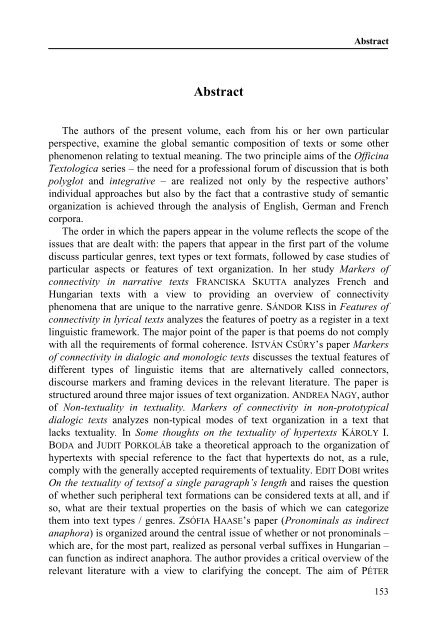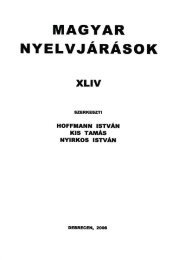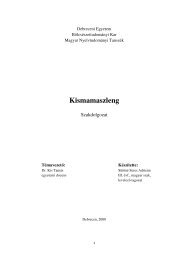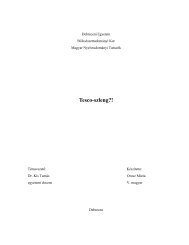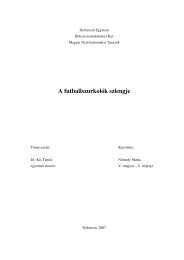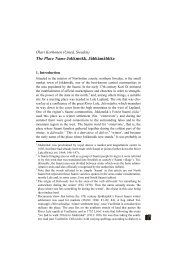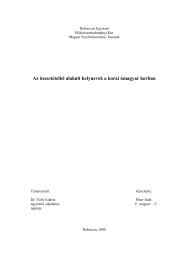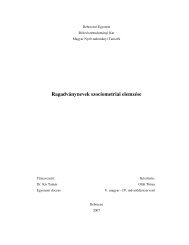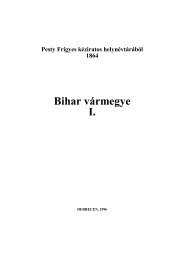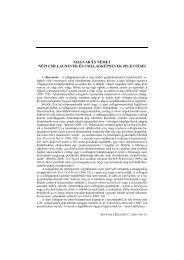Officina Textologica 17. - Magyar Nyelvtudományi Tanszék ...
Officina Textologica 17. - Magyar Nyelvtudományi Tanszék ...
Officina Textologica 17. - Magyar Nyelvtudományi Tanszék ...
You also want an ePaper? Increase the reach of your titles
YUMPU automatically turns print PDFs into web optimized ePapers that Google loves.
AbstractAbstractThe authors of the present volume, each from his or her own particularperspective, examine the global semantic composition of texts or some otherphenomenon relating to textual meaning. The two principle aims of the <strong>Officina</strong><strong>Textologica</strong> series – the need for a professional forum of discussion that is bothpolyglot and integrative – are realized not only by the respective authors’individual approaches but also by the fact that a contrastive study of semanticorganization is achieved through the analysis of English, German and Frenchcorpora.The order in which the papers appear in the volume reflects the scope of theissues that are dealt with: the papers that appear in the first part of the volumediscuss particular genres, text types or text formats, followed by case studies ofparticular aspects or features of text organization. In her study Markers ofconnectivity in narrative texts FRANCISKA SKUTTA analyzes French andHungarian texts with a view to providing an overview of connectivityphenomena that are unique to the narrative genre. SÁNDOR KISS in Features ofconnectivity in lyrical texts analyzes the features of poetry as a register in a textlinguistic framework. The major point of the paper is that poems do not complywith all the requirements of formal coherence. ISTVÁN CSŰRY’s paper Markersof connectivity in dialogic and monologic texts discusses the textual features ofdifferent types of linguistic items that are alternatively called connectors,discourse markers and framing devices in the relevant literature. The paper isstructured around three major issues of text organization. ANDREA NAGY, authorof Non-textuality in textuality. Markers of connectivity in non-prototypicaldialogic texts analyzes non-typical modes of text organization in a text thatlacks textuality. In Some thoughts on the textuality of hypertexts KÁROLY I.BODA and JUDIT PORKOLÁB take a theoretical approach to the organization ofhypertexts with special reference to the fact that hypertexts do not, as a rule,comply with the generally accepted requirements of textuality. EDIT DOBI writesOn the textuality of textsof a single paragraph’s length and raises the questionof whether such peripheral text formations can be considered texts at all, and ifso, what are their textual properties on the basis of which we can categorizethem into text types / genres. ZSÓFIA HAASE’s paper (Pronominals as indirectanaphora) is organized around the central issue of whether or not pronominals –which are, for the most part, realized as personal verbal suffixes in Hungarian –can function as indirect anaphora. The author provides a critical overview of therelevant literature with a view to clarifying the concept. The aim of PÉTER153


